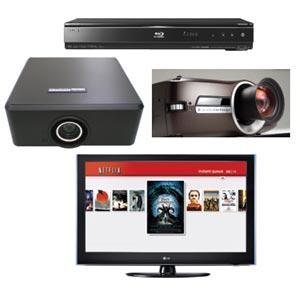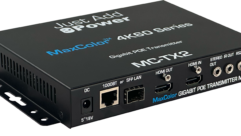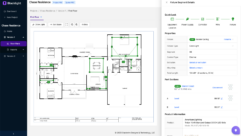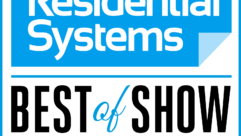

In the House: CEDIA Wrap-Up
There was an interesting vibe at CEDIA Expo this year. On the one hand, there was a home electronics installation market still suffering through the remnants of a profoundly awful housing downturn. On the other hand, there was the exciting, ongoing evolution of AV and electronic systems that will undoubtedly reach far beyond homes and home theaters and into commercial markets.
There was an interesting vibe at CEDIA Expo this year. On the one hand, there was a home electronics installation market still suffering through the remnants of a profoundly awful housing downturn. On the other hand, there was the exciting, ongoing evolution of AV and electronic systems that will undoubtedly reach far beyond homes and home theaters and into commercial markets. Here are some of the notable technology trends:
Serving Media
Companies showing products that pull multiple entertainment sources into a TV were as varied as they were many. At one end, you had manufacturers of Blu-ray players, including LG, Sharp, and Sony. Each has integrated media streaming into upcoming products. Sharp?s new BD-HP52U will stream Netflix video; LG?s BD390 touts content from Netflix, Roxio, CinemaNow, and YouTube; and Sony?s upcoming BDP-N460 (a shot across the bow of other Blu-ray makers at only $250) will stream Netflix, YouTube, music from Slacker, and other options. But these are consumer devices, notable for their simple integration.
Further up the scale was a notable new technology from Pioneer that the company calls Entertainment Tap, or ETap. It?s basically a media server platform (one of the many cozying up to home automation company Control4; see ?Software Suite,? next page) that can stream local or online content. But perhaps its biggest lure is support for Blu-ray Managed Copy, which allows users to rip a legal copy of a Blu-ray disc. Individual studios will decide if/what they charge for a ripped copy. Here?s hoping it?s exactly zero dollars–after all, you already bought the thing.
Pioneer officials at the show said not to expect an ETap system until mid-2010, and it wasn?t clear what one might cost. But the prototype on display had a huge 1TB hard drive and a Control4 HC-500 controller (not the company?s entry-level controller), so it probably won?t be cheap. But Pioneer told Pro AV it would be less than people might think. As a home controller, it?s a single-room device. To take the increasingly familiar Control4 interface and extend it to lights, media, security, and other systems throughout a home, Pioneer said it would provide users with information about Control4 dealers who could do the integration.
And at the high end of media serving was Crestron?s Adagio ADMS, which the company pointedly called an ?intermedia delivery system.? In addition to everything the Adagio system has always done, the ADMS does an exceptional job of integrating online content. Crestron officials said the company wrote its own browser and its new WorldSearch search engine for finding content at places like YouTube, Vudu, and others. In demonstrations, the integrated online tools were seamless, fast, and powerful.
Fighting For Control
Speaking of Crestron, the number of companies homing in on the control business appears to be off the charts, in large part because home automation remains far from commonplace in the mainstream market. And they?re coming from a variety of angles. Universal Remote Control was previewing its coming line of KP-4000 in-wall touch panels (it?s working on drivers to integrate AV, lighting, thermostats, security cameras, and other products), and lighting control manufacturer Lutron decided it couldn?t sit around idly while Crestron and others pushed into lighting control. The new versions of Lutron?s wireless RadioRA 2 and HomeWorks QS systems include support for basic AV and thermostat control. And users can do it from, you guessed it, a new 4.3-inch in-wall touch pad.
Light Bulbs Go Off
Finally, new LED-illuminated, front-projection systems provided a tantalizing glimpse into the future of a pro AV staple system (to say nothing of the pervasive LED-lit LCD flat-panels on display).
LED projectors from Digital Projection (with its M-Vision Cine LED),
Projectiondesign (the Avielo Helios line), and Runco (QuantumColor Q-750i and Q-750d) demonstrated today?s ideal use of LED projection technology–dark home theaters. Both Digital Projection and Projectiondesign also offer commercial LED projectors, but with the modest light output from current LED technology (600 to, at most, 1,000 lumens), their application is limited to installations with little ambient light.
Still, it?s hard to argue with the prospect of 100,000-hour lamp life and energy efficiency. And if demos showed anything, it?s that current LED projectors can produce rich, colorful images. Pro AV columnist Pete Putman saw all three lines at CEDIA Expo and expects double the light output in the future, making LED projectors suitable for general-purpose applications. For now, they offer another promising peek at where AV technology is heading.










